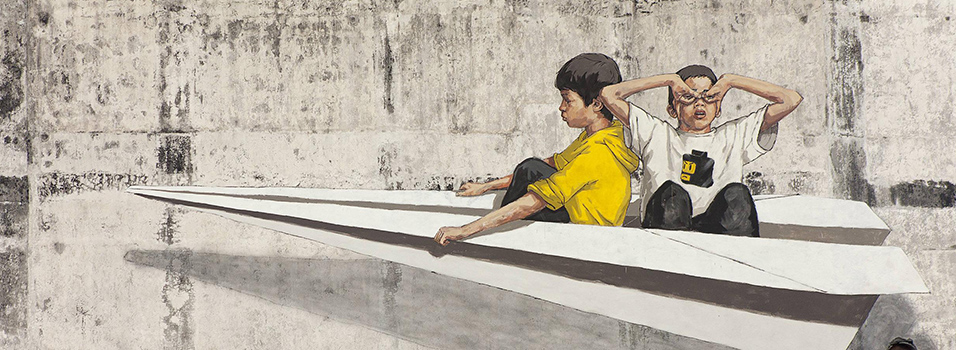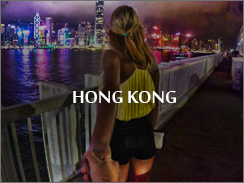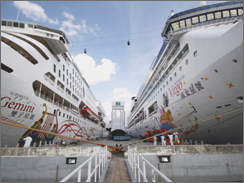The good, bad and ugly of street artist Ernest Zacharevic's murals
SINGAPORE - Just search the hashtag #penangstreetart or Google "Georgetown murals" and more likely than not, images by artist Ernest Zacharevic pop up. You may not know his name, but you'll definitely recognise his distinctive style - paintings of children, sometimes accompanied by props such as a chair or supermarket trolley on the walls of aged buildings and shophouses.
Zacharevic is so synonymous with Penang that its tourism board, Visit Penang, has one of his artworks - that famous mural of two carefree children on a bicycle - as its official Instagram photo. Tourists follow maps and embark on trails to seek out his murals scattered throughout Georgetown. Meanwhile, souvenir shops hawk magnets, T-shirts, keychains, postcards and every imaginable knick-knack bearing one or all of his creations.
It's an association the soft-spoken Lithuanian artist feels conflicted about. "I'm really flattered that my art, and art in general, could have such an effect on a community, an area, in a city itself. On the other hand, it brings in a lot of dramatic dynamics - suddenly, street art is attracting so much (attention)," he said.
"A lot of local businesses depend on it now. Organisations explore it, exploit it and find a way to depend on it. Many locals are concerned about the quality of the art, which goes public at the moment and the traffic it attracts. It has good and bad, nevertheless, it'll be interesting to see the change."
Zacharevic's work is also part of a smaller change over at the lobby of the Ritz-Carlton Millenia Singapore, where he was based last week as one of the five artists whom the hotel commissioned to create artworks from, while its restaurants Greenhouse and Summer Pavilion undergo renovation. It's hardly his first work here - he has already put his stamp on the shophouses along Perak Road, Victoria Street and Joo Chiat. See a pattern here?
Q: What is it about heritage areas and old buildings such as shophouses that draw you to paint on them?
A: I find cities in South-east Asia, especially Georgetown, changing very rapidly and dramatically. I'm curious to explore this through public space, city planning and architecture. That's what I highlight in my work. I see a state of change that local people perhaps don't notice as it's something they live with every day. It's almost my preference to work with ageing architecture, buildings and local communities that have been there for years. They're parallel to what street art is - temporary. When you put your artworks out in public, you can never predict where they are going to go and how long they are going to stay.
Q: So how do you feel about the fact that your murals may be gone at any time or even vandalised?
A: They've already lasted longer than expected. I thought they would last only for weeks. It has been years and they're still there. Locals (in Penang) are putting in effort to maintain and preserve them. The most obvious example is the mural with the motorbike. I found the motorbike abandoned on the street and every single bit that could be stolen from it had been stolen. I put some bits and pieces to make it look like a motorbike and stuck it to the wall. It looks better now than it did initially because locals replaced the seat, headlights, and petrol tank - which kept getting stolen and was probably replaced two or three times. The chair in the mural of the standing little kid has been replaced at least five to six times. The mural of the little children on a bicycle was also vandalised and the community gathered to repair it. I was in Europe at that time. I accept that my artworks are temporary. From my point of view, let it fade.
Q: Social media and the Internet have helped fuel the popularity of these images as well.
A: They really have. As with many things in street art, Banksy is kind of a pioneer in these aspects in the way he used the Internet to spread the word. Due to the temporary nature of street art, it's important to document and share it in one way or another. It now takes only one tweet or a Facebook post for anyone to see and notice it. It doesn't even matter how long the work is there. I've experienced first-hand the power of social media with regard to my paintings in Penang.
Q: Why do you think the mural Little Children On The Bicycle is so popular with visitors? It has been Instagrammed endlessly.
A: It's the one where everything comes together, like location, setting and message, perhaps. That makes it convenient and obvious to be highlighted in many different channels. A lot of it has to do with media, social media and marketing. It's like a song. There could be a beautiful album full of amazing songs, but you're going to remember the one that's played most on the radio. That's how I feel about my bicycle painting. People may not know my name or recognise where Penang is, but they will know children on a bicycle.
Q: You mentioned there are some good and bad aspects of street art in Penang. Can you tell us more?
A: It's quite a sudden change (in Penang). They (the community and authorities) try to help maintain the art, but art culture needs to be about education, funding and financing to help artists rather than building a hotel and getting someone to paint it. At the moment, I see a lot of businesses and institutions not really focusing on what it should be like. You see a handbag shop opening and calling itself a museum; a shophouse says it has something to do with heritage or the arts, but it's really a souvenir shop. Guests who visit leave disappointed. I think this situation will take some time to settle into its natural order and find a balance. There are a lot of local artists who're inspired to come out and do something. I see more and more of them coming to Penang from all over Malaysia and overseas because of the opportunities and dynamics. Eventually, in the long term, there'll be a positive change.
Q: You stopped over in Penang as part of your back-packing holiday in Asia in 2011, but why did you choose to be based there?
A: I went to Penang to visit a friend I met in university in London. It wasn't even my first stop. You sometimes get inspired - you want to do things and not want to leave until you get these artworks out. That was just how I felt. I felt like I was there at the right time and place. There were no more important things to drag me out. I see travellers stopping by and leaving because they have jobs to go back to or family obligations, or they want to paint somewhere else. But George Town sort of just sucked me in. I really wanted to stay to paint something. Then I wanted to paint something else, then there's an exhibition, then I met some artists and we worked together. These dynamics held me back, which is great.
Q: Don't you desire to be based in a bigger city or look to a particular building to paint?
A: No, I don't see my painting or even my travelling that way. I never look at the destination, it's a journey. I'm the sort of person who looks around and tries to see something beautiful around me. I keep myself inspired wherever I am. There has been a point in my life where I would really, really want to do something big and ambitious - I didn't want to do anything else. Eventually, you have to give that up to do other things that will build you up to the point you dreamt of.
- TODAY














